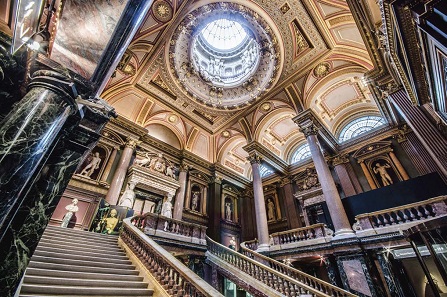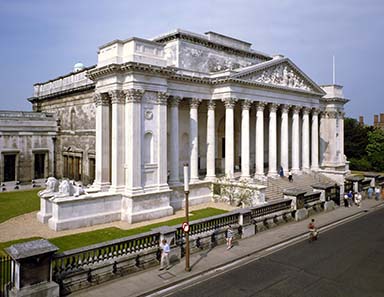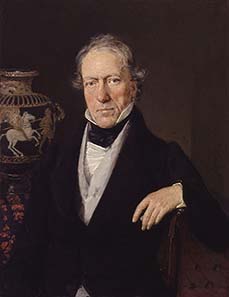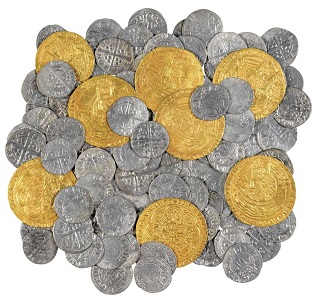by Richard Kelleher, Fitzwilliam Museum
courtesy Money & Medals Newsletter
May 5, 2016 – On 4 February 1816, Richard, 7th Viscount Fitzwilliam of Merrion, died. In his will his collection of 144 paintings (including masterpieces by Titian, Veronese and Palma Vecchio), 300 carefully ordered albums of Old Master prints, and a magnificent library with illuminated manuscripts, musical autographs by Europe’s greatest composers and 10,000 fine printed books, was left to the University of Cambridge, along with £100,000 for ‘a good substantial Museum’ to house them, and for the ‘increase of Learning and other great Objects of that Noble Foundation.’ Fitzwilliam’s bequest marked the birth of one of the finest museums in the country, described by the Standing Commission on Museums & Galleries in 1968 as ‘one of the greatest art collections of the nation and a monument of the first importance’.
The Founder’s entrance by Edward Middleton Barry, 1875.
The Founder’s Building, designed by George Basevi (1794-1845), and completed after his accidental death by C R Cockerell (1788-1863), opened to the public in 1848. Fitzwilliam’s bequest, like many contemporary collections, was wide-ranging, and set the tone for the development of the museum collection in the two centuries since. The Fitzwilliam’s newly redesigned website tells us that ‘throughout the nineteenth and twentieth centuries, the collections have grown by gift, bequest and purchase; their history is a continuous one which traces the history of collecting in this country over the last two hundred years. If the Museum owed its foundation to a Grand Tourist, it went on to benefit from the shift of taste towards the Middle Ages and the early Renaissance for which the Gothic Revival of the nineteenth century was responsible. By the same token, many of the Museum’s early twentieth century benefactors may be counted among the heirs to the Arts and Crafts and Aesthetic Movements’. The history of the museum is the subject of a comprehensive new book ‘The Fitzwilliam Museum: A History’ by Lucilla Burn.
Coin cabinet made of wood from the York Minster. Image: UK.
Today the Fitzwilliam is the flagship of the University’s eight museum sites. The Department of Coins and Medals is one of five curatorial departments in the museum. Coins were not part of Fitzwilliam’s initial bequest of 1816, although they were part of individual college and university collections. The Museum’s current holdings, of more than 220,000 coins, medals, tokens, banknotes, and other numismatic ephemera, were formed by the transfer of the collections of colleges to the Museum and many important bequests which were vital to the quality and scope of the collection.
The Fitzwilliam Museum. Photograph: Fitzwilliam Museum.
The University Collection was begun with the bequest of Andrew Perne, Master of Peterhouse, in 1589 and this material was housed with other bequests in the University Library until 1856, when it was transferred to the Museum.
Colleges were encouraged to deposit their collections by the Syndicate (Trustees) in 1937-1938. Of these Trinity is the largest and most varied. Important Roman material came from St John’s College and the Lewis Collection of 7100 coins was placed on loan by from Corpus Christi in 1991. The Pembroke College hoard found during demolition of the Master’s Lodge in 1874-75 is a fine small hoard of 41 Tudor and Stuart gold coins. It was concealed in 1642-4 during Civil War and came to the Fitzwilliam in 1958.
William Martin Leake, oil painting by Christian Albrecht Jensen. Source: Wikipedia.
The most important collections to come to the Museum were individual bequests. The collection of more than 20,000 Greek coins is one of the world’s finest, thanks to the bequests of Col. W.M. Leake, the Greek topographer, in 1864, and J.R. McClean in 1906 and 1912. The collection of Roman and English coins of the Cambridge Antiquarian Society was gifted in 1886 and in 1899, the collection of 13,200 coins of the Rev. W.G. Searle of Queens College, first honorary keeper of the Department of Coins and Medals. In recent years the important Anglo-Saxon and British collection of Christopher Blunt (1991) and the 20,000 coins of medieval Europe assembled by Prof. Philip Grierson has elevated the medieval collection to one of the very best in the world.
The Chesterton Lane Corner hoard.
The 14th century Chesterton Lane Corner hoard, found in Cambridge, is an important part of the coin display in the Rothschild Gallery. The generous support of the Prof. Ted Buttrey fund, among others, enables us to continue to add to the collection.
The back study room. Photograph: UK.
Departmental staff are engaged in teaching within several departments of the University of Cambridge and in other British universities, as well as undertaking original research. A number of important projects are based in the Department; The Sylloge Nummorum Graecorum is a British Academy project, the purpose of which is to publish illustrated catalogues of Greek coins in public and private collections in the British Isles; The Medieval European Coinage series has two new volumes in press this year; volume 12 on Northern Italy by William Day, Jr., Michael Matzke and Andrea Saccocci, and volume 8 on Britain and Ireland c.400-1066 by Rory Naismith; the Early Medieval Corpus continues to publish new single finds of coins c.600-1180; and the Noviodunum Archaeological Project, is jointly run in collaboration with UCL, is investigating the Roman and Byzantine site on the Danube.
Coins and Medals events in 2016
The department will be busy with numismatic events over the rest of the year. We are hosting this year’s Joint Meeting of the British and Royal Numismatic Societies entitled on Saturday 16 July. This is entitled ‘A Sense of Place: Coinage in context from the Iron Age to WWII.’ An exciting roll of speakers and subjects has been assembled to cover numismatics from prehistory to the modern period. The programme is as follows:
- Dr Ian Leins (English Heritage), ‘The Coins from the Cave: Iron Age and Roman coin deposits from the Derbyshire Dales.’
- Dr Sam Moorhead (British Museum), ‘The Excavations at Ipplepen – where numismatics and archaeology meet.’
- Dr Adrian Popescu (Fitzwilliam Museum), ‘Noviodunum: Coins from a Roman and Byzantine town on the Danubian frontier.’
- Dr Andrew Woods (York Museums Trust), ‘Kings and Coins: Interpreting the Early Medieval coinage from Rendlesham.’
- Stefano Locatelli (University of Manchester), ‘Rethinking the Florentine gold florin: new perspectives from 13th century coin hoards and archival sources.’
- Dr Gilly Carr (University of Cambridge), ‘Of coins, crests and kings: symbols of identity and resistance in the occupied Channel Islands.’
The fee for the day is £18, which includes a buffet lunch and refreshments. To book your place please click here.
Alternatively you can send a cheque to Richard Kelleher at The Fitzwilliam Museum, Trumpington Street, Cambridge, CB2 1RB. We look forward to seeing you there!
In October the International Symposium in Early Medieval Coinage returns to Cambridge for its sixth incarnation, and runs from Friday 28 to Saturday 29 October. The event is being organised by Tony Abramson and Alison Leonard and the overall theme is North v South. Potential speakers are invited to submit a c.200-word abstract before 31 May. Both short (10 min) and long (20 mins, plus 5 for questions) sessions are being organised to allow the maximum number of speakers to participate. Please stipulate the length of your paper when submitting your abstract.
Each month of this bicentenary year the museum will be featuring a special piece from the collection as Object of the Month. Look out for two important pieces from our collection later in the year!
The article appeared in the Money & Medals Newsletter 67, April 2016, pp. 5-6.
For more information on the Fitzwilliam Museum go to the museum’s website.
CoinsWeekly visited the Fitzwilliam in 2011 – please find our report on this exciting trip!









